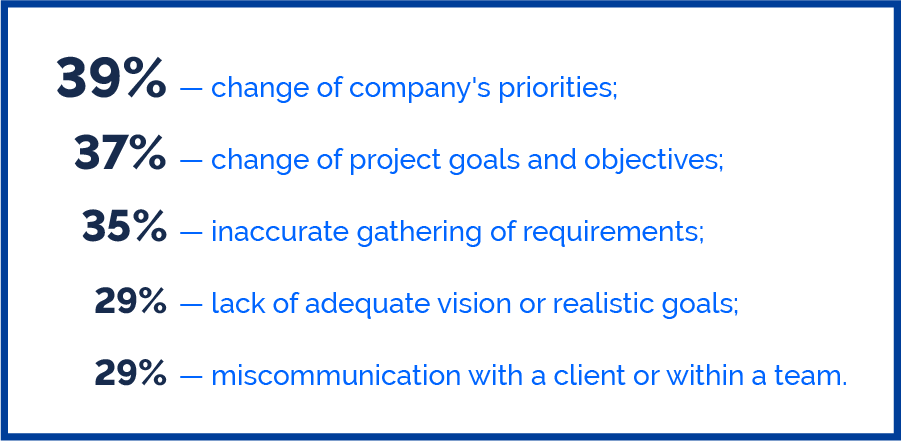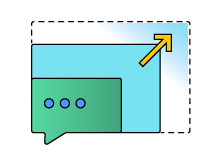All Articles
How to Make Sure Uncertainty and Miscommunication Aren’t Hurting Your Project
People undercommunicate a lot and underestimate the impact assumptions and silence can have on a project. Here’s how to avoid these things and increase your efficiency by promoting clarity in your project management.
Boost Efficiency of Your Project Management by Reducing Uncertainty
According to statistics, there are five reasons why projects fail:

As you can see, one of the main five factors that affect the success of a project is miscommunication. Why does it occur?
Project Managers Take Communication for Granted
Project managers and other team members talk via emails, at meetings, when updating tasks and documents. Despite such a variety of means and channels, it’s not the best way to maintain productive communication.
Within this framework of topic-related discussions, employees are often hesitant to ask questions, prompt for more details, request directions, etc. Managers can be unaware that someone’s struggling with their tasks, lacks feedback or visibility, or doesn’t understand the value of their work — all this affects performance within the project and people’s job satisfaction.
Lack of Communication Plan
A communication plan is a blueprint on how the communication between team members works. It explains who can provide relevant data to whom, who to address when someone’s having issues with a particular part of the project, etc.
This plan is especially important for companies that work with remote staff in different time zones. Without it, employees might be unaware who to ask for help and end up not asking anyone at all.
Absent Stakeholders
Businesses often have absent, disengaged “big bosses” that are supposed to convey a company’s values, its progress on the market, share clients’ feedback, and help employees realize their value for the enterprise. Due to lack of involvement and attention from their side, employees often don’t see their contribution to the company’s success and disengage.
That factor also refers to one of the five reasons for a project’s failure we’ve discussed before: stakeholders should be the first to articulate priorities, changes, crises, and goals of the company. None of those should “unexpectedly” change — even in crises, employees need to be aware of a business’ crisis management strategy. And yet, this happens.
All of these factors equally impact work with clients and teamwork. So, what should you do to avoid them?
We’ve outlined a few recommendations on reducing uncertainty both with clients and with employees. Most of them are grounded in establishing a culture of no assumption within the company.
 With Clients: Establish a Clear Common Ground
With Clients: Establish a Clear Common Ground
Establish a glossary. Create a glossary with all KPIs, client’s goals, and tone of voice you should use. Talk about what’s a success and what’s a failure. Outline everything about the client’s tech & features requirements. Create clear documentation on user research, get clients to validate it, and make it accessible for everyone on the team. Write down their expectations and how they’re changing. Define “urgent” tasks and how to handle them.
Push for clarity in decision-making. All these documents above are supposed to make decision-making easier. For some changes, you’ll need tools like Clarity Map — a Confluence project management software solution that lets everyone know about changes in client’s requirements, goals, etc.; it’s useful to have this kind of visualized documentation for everyone to access.
Draw boundaries and outline priorities. Find out when you should write clients you’re pushing the deadline — and when they should call if something went wrong in production; know how quickly you should react in cases like that. Figure out how deep they want to be involved in project management and how often they’d like to receive updates. Discuss the most tedious cases: imagine you’re creating software for removing places where uncertainty could appear. You won’t predict everything and you shouldn’t try — it can just draw you in a loop of trying to foresee risks instead of preparing infrastructure to manage them efficiently.
Encourage feedback and be receptive to it. Don’t hesitate to follow up after you’ve implemented the fix the client’s told you about and ask about what has prompted it (not if they’ve found a bug, though; this has to be an unexpected change.) That way, you’ll find out how the client thinks, what worries them, what trends are they following, and how they approach the development of their product (content, services, etc.)
 With Teams: Encourage Questions and Honesty
With Teams: Encourage Questions and Honesty
Teach them to understand the client. With the glossary you’ve established, that should get easier. Explain to your team every detail of what the client wants and needs. Provide them with the big picture of what the project must look like in the end. Give them time to research the niche the client is working within, brainstorm the product’s goals, etc.
Encourage the team members to ask questions. If somebody doesn’t get what to do, encourage them to ask again. Be a bridge between them and clients — there is immense value in your employees’ angle on the product that can be harnessed into improvements, save money for the client, etc. To make sure your team is not hesitant to ask questions that might sound stupid, start asking them first: about tech things you might not understand, about design decisions, about what they think could be done differently, etc.
Provide your team with feedback. Feedback is often given only when change is required — and people perceive the requests for change as something negative (though sometimes it’s formulated as such, it’s the whole other thing). If your team does something good, tell them about it in as much detail as you’d talk about their mistakes. If they do something wrong, explain what exactly and provide them with actionable recommendations on how to improve. Be direct and honest and don’t hint someone is underperforming. Hinting produces assumptions.
Explain your decisions and get stakeholders to give background to theirs, too. Connect the work your team is doing to high-level goals.
Cut the tech. Teams often use lots of software to get things done — project management software included. Despite the fact it does great things to make processes and operations more transparent, it’s also a lot. Reduce the complexity of the tech you’re using. Optimize it, structure documentations, and try to use fewer tools — or tools that can connect. For instance, there are task managers that allow you to create Jira tickets from Confluence, combining two major pieces of software for project management.
Conclusion
Uncertainty hurts the project. Assuming you know what the client is talking about and then having to redo everything is bad for your revenue, clients’ revenue, your employees, stakeholders — everyone.
Communication is difficult, but ‘no communication’ is way too expensive. There are also a lot of other recommendations related to establishing it — for instance, on what’s good feedback and what’s bad feedback, on creating a culture where change isn’t negative but a constant, on explaining why talking to everyone is so important to stakeholders. But to start reducing uncertainty, this article would be enough.
You may think it’ll take a lot of time, but guess what — redoing things will take much longer. Also, communication makes collaboration possible; it helps employees be independent and more driven to take responsibility for their decisions. That way, your team’s efficiency and creativity will rise — as well as their motivation to do better.

Stay on Top of the Latest IT Software Development Tips, Newest Offshore Trends, and Best Outsourcing Practices.


